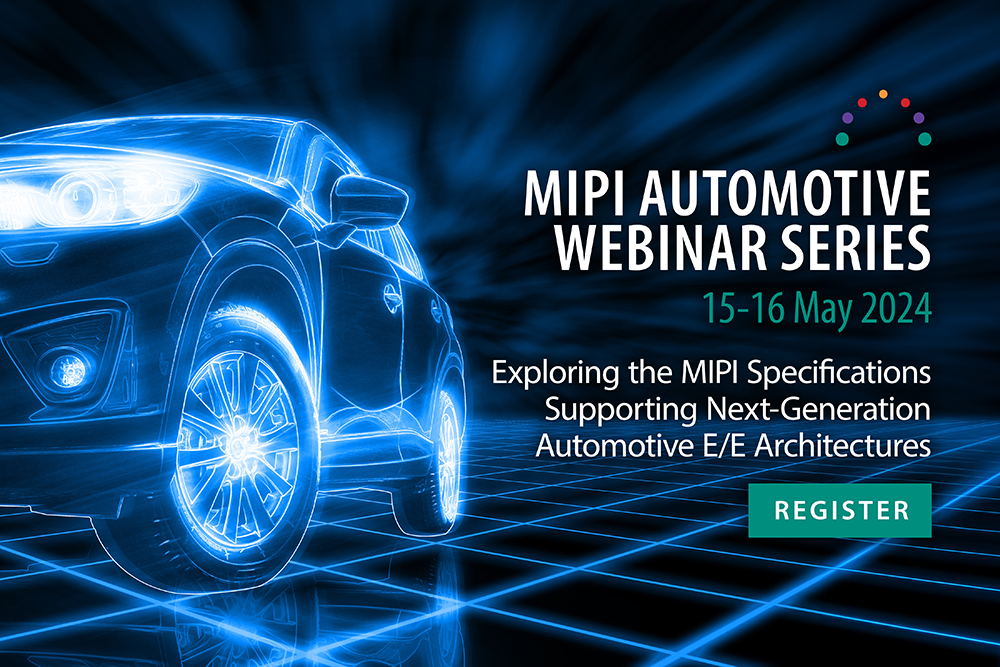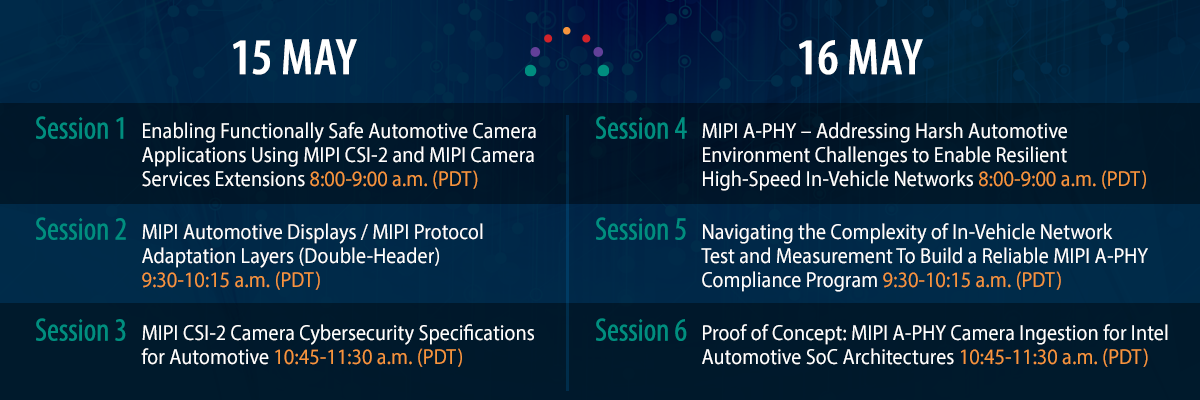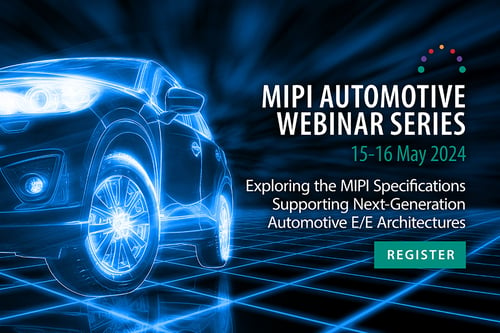9 min read
Upcoming: MIPI Automotive Webinar Series: Exploring the MIPI Specifications Supporting Next-Generation Automotive E/E Architectures
![]() MIPI Alliance
:
28 February 2024
MIPI Alliance
:
28 February 2024

- Resources
- Webinars & Workshops
MIPI Automotive Webinar Series
15-16 May 2024
Three webinars each day, 8-11:30 a.m. (PST)

Machine-vision-enabling image sensors and advanced in-vehicle displays are essential enablers for advanced driver-assistance systems (ADAS) and autonomous driving systems (ADS). As the number of image sensors and displays increases, to enable ever more capable systems within each new generation of vehicle, MIPI CSI-2 (a standardized image sensor protocol) and MIPI DSI-2 (a standardized display protocol), are becoming ever more essential to automotive E/E architectures.
Join us for a series of six MIPI webinars that will provide a comprehensive overview of MIPI automotive initiatives supporting and streamlining the integration of state-of-the-art images sensors and displays into next generation E/E architectures. The series will include sessions that demonstrate real-world application of MIPI interfaces in the automotive market. All sessions will include time for interactive audience questions and answers.
The series is targeted for automotive developers, system architects and engineering managers who are focused on the development, integration and test of next-generation advanced driver-assistance systems (ADAS), autonomous driving systems (ADS), automotive machine vision systems, and in-vehicle display systems.
Webinars and Presenters
Enabling Functionally Safe Automotive Camera Applications Using MIPI CSI-2 and MIPI Camera Services Extensions
15 May | 8-9 a.m. (PDT)
Presenters: Peter Lefkin, Haran Thanigasalam and Ariel Lasry
After a short introduction to the use of MIPI specifications within the automotive market, this session will focus on the use of the MIPI Camera Serial Interface 2 (CSI-2) camera protocol and associated MIPI Camera Services Extensions (CSE) specification to enable functionally safe and secure automotive camera applications.
The session will describe the MIPI CSI-2 capabilities that benefit automotive imaging systems, enable sensor aggregation optimization, realize superior objective image quality, and help system energy consumption reduction. Presenters will discuss CSI-2 provisions to alleviate RF emissions while supporting “region of interest" extraction, always-on inferencing, wire reduction and reduction of current leakage, and highlight available physical layer options. In addition, the session will explore the functional safety capabilities provided by the MIPI CSE specification, which defines extended functions for CSI-2 that can be leveraged within automotive imaging systems to achieve functional safety goals from ASIL B through to ASIL D.
Presenters
-
Peter Lefkin
 Executive Director & Secretary, MIPI Alliance
Executive Director & Secretary, MIPI AlliancePeter Lefkin has been providing leadership and guidance to the standards development community for more than 20 years. In 2022, he was promoted to executive director of MIPI Alliance, after having served as its managing director since 2011. As MIPI's senior staff executive, he is responsible for all MIPI activities and operations, from strategy development to implementation, and also serves as secretary to the MIPI Alliance Board of Directors.
Peter's background includes previous leadership roles at the American National Standards Institute, Motorola and the IEEE Standards Association. As COO/CFO for IEEE Industry Standards and Technology Organization (IEEE-ISTO), he was instrumental in the formation of multiple standards groups, including the founding of MIPI Alliance in 2003.
-
Haran Thanigasalam
 Camera and Imaging Consultant, MIPI Alliance
Camera and Imaging Consultant, MIPI Alliance
Lead of the MIPI Camera Interest GroupHaran Thanigasalam is a camera and imaging consultant for the MIPI Alliance. In this role, he facilitates the advancement and evolution of the CSI-2 imaging conduit solutions spanning consumer, commercial and infrastructure platforms. Prior to joining MIPI, Haran was a camera architecture engineering program manager at Apple and distinguished senior platform architect at Intel. While at Apple and Intel, he worked closely with multiple cross-domain experts and vendors to develop system engineering solutions to manifest bespoke imaging capabilities on iconic product platforms. He has 20 years of experience developing solutions for imaging and optical networking systems.
-
Ariel Lasry
 Director Technical Standards, Qualcomm Technologies Inc.
Director Technical Standards, Qualcomm Technologies Inc.
Vice Chair of the MIPI A-PHY Working Group and member of the MIPI Camera Working GroupAriel joined Qualcomm in 2021 as director, technical standards. He is actively engaged with standardization activities across multiple SDOs, including the MIPI Alliance, where he has been contributing to several working groups since 2009.
Prior to Qualcomm, Ariel was chief engineer at Toshiba Electronics Europe, where he was responsible for strategic business planning and standardization. Ariel represented Toshiba on the MIPI Alliance Board of Directors from 2012 through 2020. In his early career, Ariel worked as a SoC design engineer at SGS-Thomson Microelectronics (now STMicroelectronics).
MIPI Automotive Displays and MIPI Protocol Adaptation Layers (Double-Header)
Part 1: Using MIPI Display Specifications To Meet the Growing Bandwidth and Safety Requirements of Next-Generation Automotive Displays
Part 2: How MIPI Protocol Adaptation Layers Enable MIPI Higher Layer Protocols Over Automotive In-Vehicle Networks
15 May | 9:30-10:15 a.m. (PDT)
Presenters: Ariel Lasry and Nadav Banet
This two-part session will provide an overview of MIPI protocols to enable automotive displays and describe the MIPI protocol adaptation layers (PALs) that enable the use of higher layer protocols over in-vehicle networks (IVNs).
Part 1 will detail the MIPI specifications that standardize and streamline connectivity of automotive displays to their associated ECUs, with built-in functional safety and security support. The presentation will describe the components of the MIPI automotive “display stack,” which includes MIPI DSI-2 and MIPI Display Services Extensions (DSE) specifications, with particular emphasis on functional safety features, and support for multiple connectivity topologies, heterogeneous displays and lossless compression.
Part 2 will provide an overview of the MIPI PALs that define the adaptations necessary to carry MIPI (and approved third-party) protocols over IVN physical layer links. The presentation will cover existing MIPI A-PHY PALs, which include PALs for MIPI CSI-2, MIPI DSI-2, VESA eDP/DP, Ethernet, I2C, SPI and GPIO, and offer a preview of upcoming PALs for MIPI I3C over A-PHY and MIPI CSI-2 over IEEE1722.
Presenters
-
Ariel Lasry
 Director Technical Standards, Qualcomm Technologies Inc.
Director Technical Standards, Qualcomm Technologies Inc.
Vice Chair of the MIPI A-PHY Working Group and member of the MIPI Camera Working GroupAriel joined Qualcomm in 2021 as director, technical standards. He is actively engaged with standardization activities across multiple SDOs, including the MIPI Alliance, where he has been contributing to several working groups since 2009.
Prior to Qualcomm, Ariel was chief engineer at Toshiba Electronics Europe, where he was responsible for strategic business planning and standardization. Ariel represented Toshiba on the MIPI Alliance Board of Directors from 2012 through 2020. In his early career, Ariel worked as a SoC design engineer at SGS-Thomson Microelectronics (now STMicroelectronics).
-
Nadav Banet
 Nadav Banet, Director of System Architecture, Valens Semiconductor
Nadav Banet, Director of System Architecture, Valens Semiconductor
Lead of the MIPI Camera and Display Protocol Adaptation Layer SubgroupsNadav Banet is a co-founder of Valens Semiconductor and currently serves as the company’s director of system architecture within the CTO Office. A veteran of the industry, Nadav has more than 25 years of experience in software, architecture, technology and management.
Nadav has worked with the MIPI Alliance since 2017 and has been an active member in four working groups: Camera, Display, Security and A-PHY. He has led the PAL subgroup within the Camera and Display groups, and has also led the PAL and CTS activities within the A-PHY Working Group.
Nadav has a bachelor of science in computer science and mathematics. Prior to co-founding Valens Semiconductor, Nadav held engineering and managerial roles at National Semiconductor, MystiCom and Transwitch.
MIPI CSI-2 Camera Cybersecurity Specifications for Automotive
15 May | 10:45-11:30 a.m. (PDT)
Presenter: Rick Wietfeldt
This session will describe the approach MIPI has undertaken, through provisions in four upcoming specifications, to secure connections between MIPI CSI-2 image sensors and their related ECUs from the perspectives of authentication, integrity and confidentiality. It will explain how security can be applied to CSI-2 data streams and how MIPI’s application-based security approach is distinct from other methods in its extent and configurability, enabling end-to-end security at the CSI-2 protocol layer.
Presenter
-
Rick Wietfeldt
 Senior Director, Qualcomm Technologies Inc.
Senior Director, Qualcomm Technologies Inc.
Co-Chair of the MIPI Security Working Group and Vice Chair of the MIPI Alliance Board of Directors
Rick is co-chair of the MIPI Security Working Group and serves as vice chair of the MIPI Alliance Board of Directors. He is also a senior director, technology, at Qualcomm Technologies, where he established the Advanced Connectivity Technology office responsible for the standards development organizations (SDOs) that drive wired interface standards. Rick is a frequent author and has been awarded numerous patents in mobile device architecture and operation.
MIPI A-PHY High-Speed Automotive SerDes Interface – Addressing Harsh Automotive Environment Challenges to Enable Resilient High-Speed In-Vehicle Networks
16 May | 8-9 a.m. (PDT)
Presenters: Edo Cohen, Raj Kumar Nagpal and Eyran Lida
This session will take a deep dive into MIPI A-PHY, the first industry-standard automotive serializer-deserializer (SerDes) physical layer interface offering native coupling to MIPI CSI-2, DSI-2 and other higher-layer protocols. The session will explain how the interface is designed to operate in harsh automotive environments that include sudden and prolonged attacks of electromagnetic interference, and dynamic channel response variations caused by thermal and humidity fluctuations. It will also explain how the interface operates reliably using interconnects, composed of multiple cable segments combined with reflection-generating inline connectors that, over years of use, suffer shielding degradation and channel attenuation. The session will:
- Introduce MIPI A-PHY, provide an overview of the enhancements delivered in A-PHY v2.0 (which doubles the downlink data rate to 32 Gbps and increases uplink data rate to over 1 Gbps), highlight the use of A-PHY in software-defined vehicles, and introduce new power-over-A-PHY power classes.
- Address the design, diagnostic and testing methodologies required to ensure robust, error-free automotive SerDes communication links throughout the vehicle lifespan. It will explain how conventional high-speed serial equalization and forward error correction methods are inadequate for automotive applications and explain how only a highly adaptive SerDes that dynamically tracks channel variations and is capable of interference cancellation will meet the signal-to-noise ratio and error rate demands required for automotive environments.
Presenters
-
Edo Cohen
 VP Automotive Products, Valens Semiconductor
VP Automotive Products, Valens Semiconductor
Co-Chair of the MIPI A-PHY Working Group and Co-Vice Chair of the MIPI Technical Steering GroupEdo is vice president of automotive products at Valens Semiconductor, spearheading standardization activities. He has more than 30 years of experience as a system engineer, specializing in system architecture, technical specifications, definition and execution. Edo is also co-chair of the MIPI A-PHY Working Group and co-vice chair of the MIPI Technical Steering Group. Prior to Valens, Edo was a system architect at Intel, heading activities in wearables and IoT.
-
Raj Kumar Nagpal
 Senior Staff Engineer, Synopsys
Senior Staff Engineer, Synopsys
Co-Chair of the MIPI A-PHY Working Group, Chair of the MIPI D-PHY Working Group and Chair of the MIPI PHY Steering GroupRaj Kumar Nagpal has more than 25 years of research and development experience in various fields of electronics, including RF engineering, high-speed serial links, signal integrity, power integrity and product validation. His work at Synopsys focuses on high-speed serial links architecture/system-level modeling, as well as signal integrity and power integrity domains of high-speed serial links. Raj has a master's of engineering degree in microwave electronics from the University of Delhi and earned his bachelor of technology degree in electronics and communication from Nagpur University.
-
Eyran Lida
 Chief Technology Officer and Co-Founder, Valens Semiconductor
Chief Technology Officer and Co-Founder, Valens Semiconductor
Member of the MIPI A-PHY Working GroupEyran Lida, the CTO and a co-founder of Valens Semiconductor, is responsible for technology, strategy development, and the company’s patent portfolio. Eyran has 30 years’ experience developing communication systems software and hardware architecture with primary expertise in wireline hardwired DSP modem design. He was the lead inventor of HDBaseT technology, holds 75 US patents, and is one of the leading technical contributors for MIPI’s A-PHY specifications.
Navigating the Complexity of In-Vehicle Network Test and Measurement To Build a Reliable MIPI A-PHY Compliance Program
16 May | 9:30-10:15 a.m. (PDT)
Presenters: Kevin Kershner, joined by Tom Kopf for Q&A segment
Integrating new technologies and protocols into in-vehicle networks presents automotive OEMs with both opportunities and challenges. The need for standardized, comprehensive testing methodologies quickly become paramount when implementing new, state-of-the-art, long-reach high-speed interconnects such as MIPI A-PHY.
This session will explain why a standardized compliance test specification and compliance program are essential enablers for new in-vehicle network technologies. The discussion will also explore how these enablers not only ensure product interoperability and compliance, but also give OEMs flexibility in component supply and high confidence in system performance, while also helping to control overall sourcing costs. With specific focus on MIPI A-PHY electrical testing, this session will highlight key requirements from the MIPI A-PHY compliance test specification and explain the general architecture of the MIPI A-PHY compliance program.
Presenters
-
Kevin Kershner
 Solution Architect, Keysight Technologies
Solution Architect, Keysight Technologies
Member of the MIPI A-PHY Working GroupAfter receiving his BSEE from UCLA, Kevin has been working in the test and measurement industry for over 18 years. With a wealth of experience as an applications engineer, he specializes in signal integrity validation for a variety of standards including USB, DDR, PCIe, and Automotive SerDes. In his current role, he is the solution architect and planner for automotive SerDes test solutions at Keysight.
-
Tom Kopf
 COO, BitifEye GmbH
COO, BitifEye GmbH
Member of the MIPI A-PHY Working GroupAfter his MBA in 1999, Tom started at a PCB manufacturer as an account manager, exiting as a manager, customer service & deputy sales manager 2012. After a 2-year period as managing director, Stadtmarketing Böblingen e.V, Tom joined BitifEye Digital Test solution in 2015. Tom is currently compiling the A-PHY compliance program for MIPI Alliance.
Proof of Concept: MIPI A-PHY Camera Ingestion for Intel Automotive SoC Architectures
16 May | 10:45-11:30 a.m. (PDT)
Presenters: Frederik John and Stephanie Friederich
This session focuses on Intel’s MIPI A-PHY proof of concept (PoC) that demonstrates the enablement of A-PHY links on the Intel x86 based automotive platform. The presentation will begin by describing how the Intel platform supports an add-in card hosting two quad MIPI A-PHY deserializers, enabling the connection of up to eight full-HD image sensors over 5-meter-long coax cables. It will also cover how the PoC implements video streaming by leveraging the connection to the MIPI CSI-2 RX ports of the system on chip (SoC), with the raw camera data being processed in the image processing unit (IPU) inside the SoC, utilizing dedicated hardware accelerators for gain control, white balance and HDR stitching. As a final step, the PoC routes the video data stream to a display to prove that the video links are functional.
Presenters
-
Frederik John
 Senior Hardware Engineer, Intel Corporation
Senior Hardware Engineer, Intel CorporationFrederik has spent more than 15 years in the electronic industry, including working for Tier-1 automotive companies, and in the defense and space industries. For the past six years, he has been a senior hardware engineer in the Intel Automotive Division, focusing on camera ingestion and FPGA implementation. Frederik has a strong background in all aspects of electronics engineering, from architecture to implementation, bring-up to debug, and analog to digital.
-
Stephanie Friederich
 Technical Lead, System Architecture, Intel Corporation
Technical Lead, System Architecture, Intel CorporationStephanie is a technical lead in system architecture in the Intel Automotive Division. She is responsible for the development of board architecture and definition of next-generation products for the automotive industry. Stephanie brings experience in developing and debugging complex system designs, including high-speed data transmission and camera technology.







